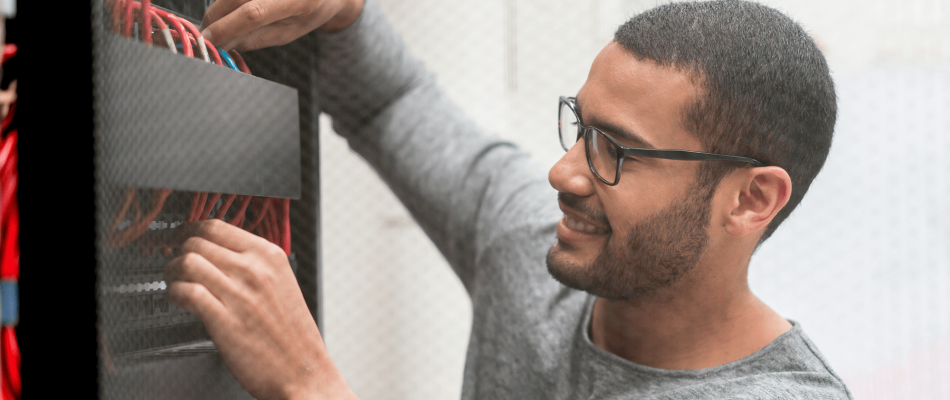Structured cabling is a complex and necessary part of any business’s telecommunication infrastructure and requires professional experience for correct installation.
It involves creating a cabling network that allows seamless integration of devices and equipment in a workplace. It provides a stable, interference-free network and communication for any office, building, or organization. There are six main components to structured cabling, namely:
- Entrance Facility
The entry point for both public and private network service cables. - Equipment Room
A room that houses the equipment that serves the network’s users. - Telecommunications Closet
A closet or room that houses telecommunication equipment to connect the horizontal and backbone cabling. - Backbone Cabling
A network of cables that connects the equipment room and telecommunications closet. - Horizontal Cabling
A network of cables that connects the telecommunications closet to individual outlets in the work area. - Work Area
The office floor where users connect work equipment to the horizontal cabling network’s outlets.
These components need to be properly connected for a structured cabling network to function correctly and without interference.
Today, we will discuss two very important components of structured cabling that connect and bring together the entire network, horizontal cabling and backbone cabling. More importantly, we will discuss the difference between horizontal and backbone cabling.
Before we start, always remember to consult the professionals at Communications Solutions Inc. in Jacksonville, Florida, for all structured cabling solutions.
That being said, let’s begin by giving you detailed descriptions of horizontal and backbone cabling.
Backbone Cabling
Often referred to as vertical cabling, backbone cabling is virtually the entire structured cabling network’s backbone. It interconnects equipment rooms, entrance facilities, and telecommunications closets.
During installation, it is common for backbone cabling to be installed from floor to floor. Multiple types of cables can be used for backbone cabling, including:
- Coaxial cables
- Unshielded twisted-pair (UTP) cables
- Fiber optic cables
- Shielded twisted-pair (STP) cables
Structured cabling best practices dictate that only cables of length under or equal to 30 meters, or 98 feet, should be used to connect the components and equipment in backbone cabling. However, with the introduction of fiber optic cables, backbone cabling can run longer than ever before.
Fiber optic cables also allow far greater bandwidth than traditional Cat6 or Cat5 twisted-pair copper cables. These reasons make fiber optic cables the best choice of cables for backbone cabling.
Horizontal Cabling
Horizontal cabling runs from the telecommunications closet, or telecommunications room, to the information outlets in the work area. Every work station in the work area is connected to the telecommunications closet through outlets that run horizontal cabling to the closet.
Unlike backbone cabling, individual cables in horizontal cabling can run up to 90 meters without breaking structured cabling best practices. This makes sense because outlets for work stations in a work area are typically spread across the entire floor.
Horizontal cabling can use both fiber optics and Ethernet cables. Ideally, UTP cabling, like Cat5, Cat6, is used for seamless, uninterrupted voice transmissions, and fiber optic cables are used for high-speed data transmissions.
These cables are connected from the outlet in the work area to a patch panel in the telecommunications closet. The patch cables used to connect the patch panel to switches and hubs in the closet should be no longer than 6 meters to allow for smooth transmissions.
Similarly, on the other end of horizontal cabling, the cables used to connect work stations to the outlets, should be no longer than 3 meters for the optimum end-user experience.
Difference Between Horizontal and Backbone Cabling
By now you can probably tell the main difference between horizontal and backbone cabling, which is that they serve different purposes in the structured cabling network. Backbone cabling interconnects telecommunication closets, equipment rooms, and entrance facilities that run between floors to make up the backbone of structured cabling.
While horizontal cabling connects individual outlets on the work area to the telecommunications closet and by extension, the entire structured cabling network.
However, this is not all. While it may seem that the cables used for horizontal and backbone cabling are similar, there are some prominent differences. The cables used in backbone cabling have to run from floor to floor, which means they have to meet certain rating likes, fire-rating specifications.
Moreover, since these cables have to support their weight, they need to have higher strength than horizontal cabling and must be secured correctly. Incorrect installation can lead to many problems with your entire structured cabling setup.
Hence, you should only opt for professional services, like Communications Solutions Inc. in Jacksonville, Florida, to install structured cabling correctly.
Conclusion
Horizontal and backbone cabling are arguably the most important part of any structured cabling network because they connect all your equipment. They are the ‘cabling’ in structured cabling.
We learned that they serve different purposes in structured cabling. However, the cable specifications, like strength and rating, set the two apart from each other. These specifications differ because of the different environments the cabling goes through.
Keep in mind, the correct installation of these cables is key to the performance and longevity of your structured cabling. Hence, you only opt for professionals to handle all your structured cabling needs.
If you want to learn more about the difference between horizontal and backbone cabling, or you want the best-structured cabling services in Jacksonville, Florida, Contact Us Today!

